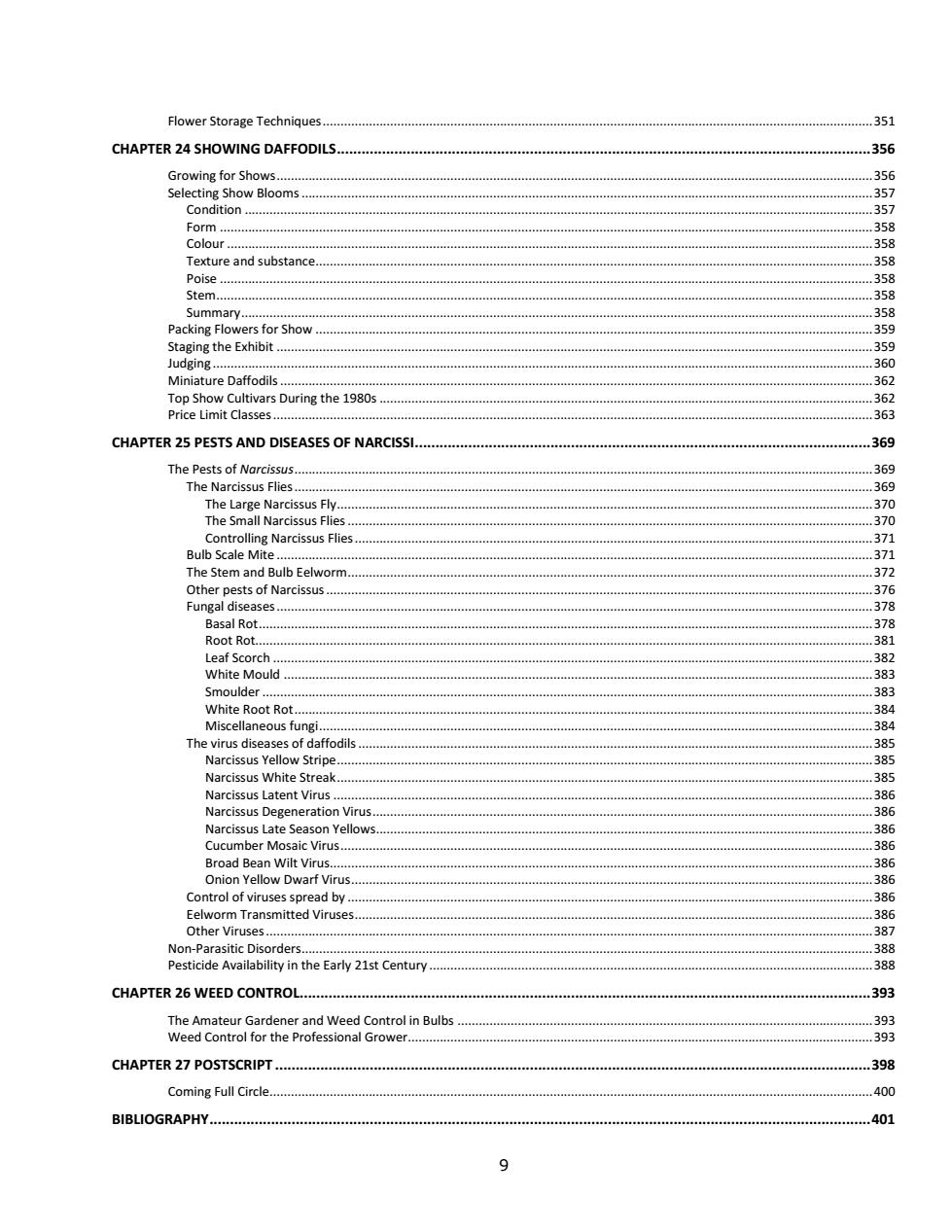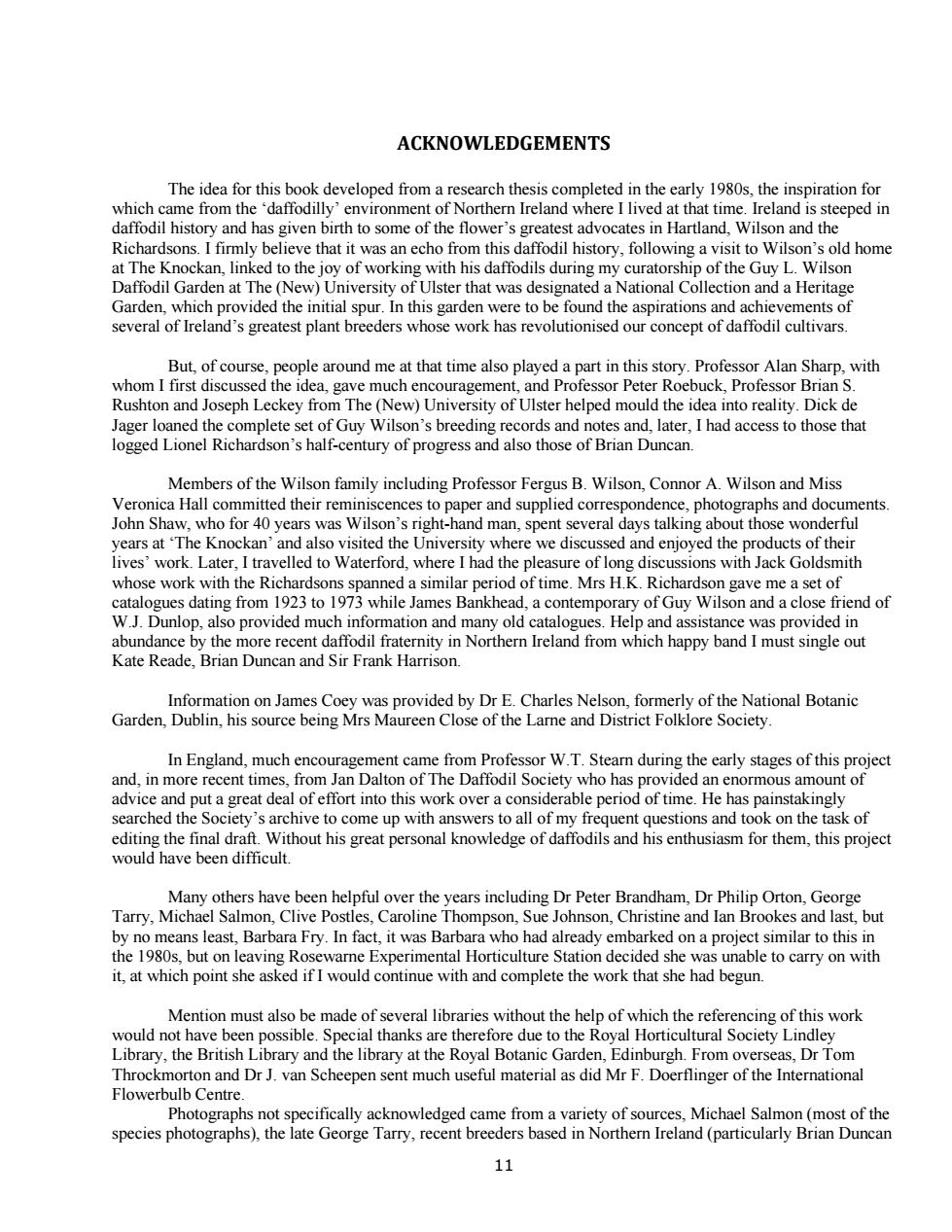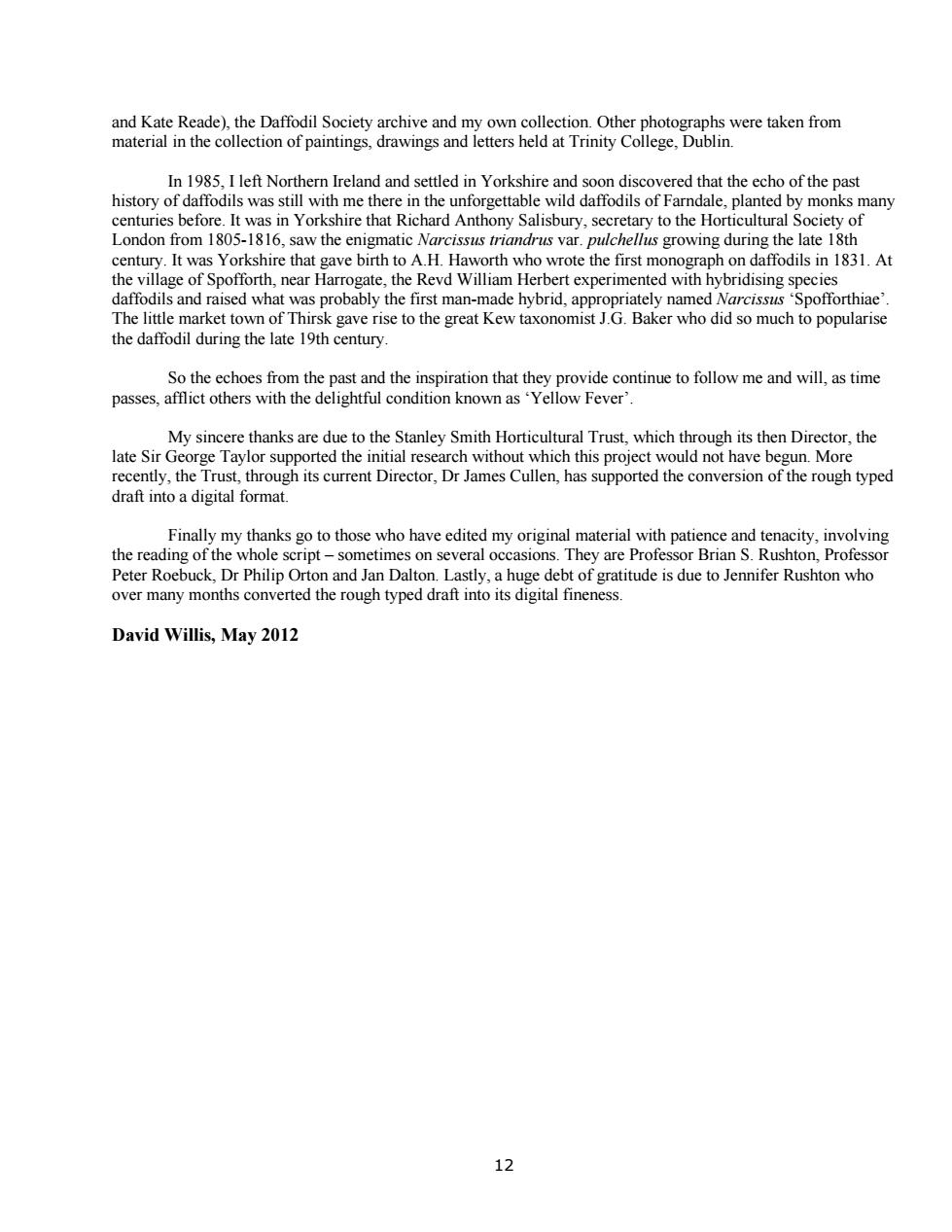
Flower Storage Technique 351 CHAPTER 24 SHOWING DAFFODILS .356 55 Texture and substance. Stem P for show 359 Staging the Exhibit 566 CHAPTER 25 PESTS AND DISEASES OF NARCISSI. 369 The Large Narissus Fly 379 he Sn cissus F Bub5aeMeNars Fungal dis ases... Root ROt. The virus disea Narcissus White Streak Narcissus Latent Virus Narcissus Late Season Yellows M irus. edd by 38 Other Viruse 388 CHAPTER 26 WEED CONTROL.... 39g The ama 39 393 CHAPTER 27 POSTSCRIPT 398 Coming Full Circle.. 40 BIBLIOGRAPHY.. 401
9 Flower Storage Techniques...........................................................................................................................................................351 CHAPTER 24 SHOWING DAFFODILS..................................................................................................................................356 Growing for Shows........................................................................................................................................................................356 Selecting Show Blooms.................................................................................................................................................................357 Condition .................................................................................................................................................................................357 Form ........................................................................................................................................................................................358 Colour ......................................................................................................................................................................................358 Texture and substance.............................................................................................................................................................358 Poise ........................................................................................................................................................................................358 Stem.........................................................................................................................................................................................358 Summary..................................................................................................................................................................................358 Packing Flowers for Show .............................................................................................................................................................359 Staging the Exhibit ........................................................................................................................................................................359 Judging ..........................................................................................................................................................................................360 Miniature Daffodils.......................................................................................................................................................................362 Top Show Cultivars During the 1980s ...........................................................................................................................................362 Price Limit Classes.........................................................................................................................................................................363 CHAPTER 25 PESTS AND DISEASES OF NARCISSI...............................................................................................................369 The Pests of Narcissus...................................................................................................................................................................369 The Narcissus Flies...................................................................................................................................................................369 The Large Narcissus Fly.......................................................................................................................................................370 The Small Narcissus Flies....................................................................................................................................................370 Controlling Narcissus Flies..................................................................................................................................................371 Bulb Scale Mite ........................................................................................................................................................................371 The Stem and Bulb Eelworm....................................................................................................................................................372 Other pests of Narcissus..........................................................................................................................................................376 Fungal diseases........................................................................................................................................................................378 Basal Rot.............................................................................................................................................................................378 Root Rot..............................................................................................................................................................................381 Leaf Scorch .........................................................................................................................................................................382 White Mould ......................................................................................................................................................................383 Smoulder ............................................................................................................................................................................383 White Root Rot...................................................................................................................................................................384 Miscellaneous fungi............................................................................................................................................................384 The virus diseases of daffodils.................................................................................................................................................385 Narcissus Yellow Stripe.......................................................................................................................................................385 Narcissus White Streak.......................................................................................................................................................385 Narcissus Latent Virus ........................................................................................................................................................386 Narcissus Degeneration Virus.............................................................................................................................................386 Narcissus Late Season Yellows............................................................................................................................................386 Cucumber Mosaic Virus......................................................................................................................................................386 Broad Bean Wilt Virus.........................................................................................................................................................386 Onion Yellow Dwarf Virus...................................................................................................................................................386 Control of viruses spread by ....................................................................................................................................................386 Eelworm Transmitted Viruses..................................................................................................................................................386 Other Viruses...........................................................................................................................................................................387 Non-Parasitic Disorders.................................................................................................................................................................388 Pesticide Availability in the Early 21st Century .............................................................................................................................388 CHAPTER 26 WEED CONTROL...........................................................................................................................................393 The Amateur Gardener and Weed Control in Bulbs .....................................................................................................................393 Weed Control for the Professional Grower...................................................................................................................................393 CHAPTER 27 POSTSCRIPT .................................................................................................................................................398 Coming Full Circle..........................................................................................................................................................................400 BIBLIOGRAPHY.................................................................................................................................................................401

NARCISSUS SPECIES AND INTERSECTIONAL HYBRIDS .…407 GENERAL INDEX. …420 10
10 NARCISSUS SPECIES AND INTERSECTIONAL HYBRIDS .......................................................................................................407 NARCISSUS CULTIVARS ....................................................................................................................................................409 GENERAL INDEX...............................................................................................................................................................420

ACKNOWLEDGEMENTS The idea for this book developed from a research thesis completed in the early 1980s,the inspiration for Whtdrdafenvironment of Northem ireland werelved at that me rland is sceped in af ha s given birth to some of the flower's greate: advocates in Hartland ilson and the y be that it was an echo om thi fodil history,following a 's old home f the T hat d a He Garden.which provided the initial spur.In this garden were to be found the aspirations and achievements of several of Ireland's greatest plant breeders whose work has revolutionised our concept of daffodil cultivars. But,of course,people around me at that time also played a part in this story.Professor Alan Sharp,with seph Lec or Peter Roet key from ne (N vers helped mo into reality.I te set Guy Wils n's breed I had access to those tha Members of the Wilson family including Professor Fergus B.Wilson,Connor A.Wilson and Miss Veronica Hall committed their reminiscences to paper and supplied correspondence,photographs and documents. John Shaw,who for 40 years was Wilson's right-hand man,spent several days talking about those wonderful years at 'The Knockan'and also visited the University w we discussed and enjoyed the ves'work d,w had the pleasure th the F ot time.Mrs H.K.R ha n gave me a set 0: iend of ide ided in bundance by the more recent daffodil frater mity in Northern Ireland from which happy band I must single out Kate Reade,Brian Duncan and Sir Frank Harrison. Information on James Coey was provided by Dr E.Charles Nelson,formerly of the National Botanic Garden,Dublin,his source being Mrs Maureen Close of the Lamne and District Folklore Society. In England,much nd.in advice and this work over a considerable searched the Societyrchive to comeuphawerstoall ofmyr riod of time.He has painstakingly uent questions and took on the task of editing the final draft.Without his great personal knowledge of daffodils and his enthusiasm for them,this project would have been difficult. e been helpful over the years including Dr Peter Brandham,Dr n, but the hut 1 Roty.In t al Horticultu ded she it.athic point sheed foudoth and compet the work that she had begun Mention must also be made of several libraries without the help of which the referencing of this work would not have been possible.Special thanks are therefore due to the Royal Horticultural Society Lindley Library,the British Library and the library at the Royal ocmorton and Drvan Scheepen sent much useful did M ofth International Throck entre owledged c of s Michael Saln nost of the recent bre ders based in Nor hern Ireland (p
11 ACKNOWLEDGEMENTS The idea for this book developed from a research thesis completed in the early 1980s, the inspiration for which came from the ‘daffodilly’ environment of Northern Ireland where I lived at that time. Ireland is steeped in daffodil history and has given birth to some of the flower’s greatest advocates in Hartland, Wilson and the Richardsons. I firmly believe that it was an echo from this daffodil history, following a visit to Wilson’s old home at The Knockan, linked to the joy of working with his daffodils during my curatorship of the Guy L. Wilson Daffodil Garden at The (New) University of Ulster that was designated a National Collection and a Heritage Garden, which provided the initial spur. In this garden were to be found the aspirations and achievements of several of Ireland’s greatest plant breeders whose work has revolutionised our concept of daffodil cultivars. But, of course, people around me at that time also played a part in this story. Professor Alan Sharp, with whom I first discussed the idea, gave much encouragement, and Professor Peter Roebuck, Professor Brian S. Rushton and Joseph Leckey from The (New) University of Ulster helped mould the idea into reality. Dick de Jager loaned the complete set of Guy Wilson’s breeding records and notes and, later, I had access to those that logged Lionel Richardson’s half-century of progress and also those of Brian Duncan. Members of the Wilson family including Professor Fergus B. Wilson, Connor A. Wilson and Miss Veronica Hall committed their reminiscences to paper and supplied correspondence, photographs and documents. John Shaw, who for 40 years was Wilson’s right-hand man, spent several days talking about those wonderful years at ‘The Knockan’ and also visited the University where we discussed and enjoyed the products of their lives’ work. Later, I travelled to Waterford, where I had the pleasure of long discussions with Jack Goldsmith whose work with the Richardsons spanned a similar period of time. Mrs H.K. Richardson gave me a set of catalogues dating from 1923 to 1973 while James Bankhead, a contemporary of Guy Wilson and a close friend of W.J. Dunlop, also provided much information and many old catalogues. Help and assistance was provided in abundance by the more recent daffodil fraternity in Northern Ireland from which happy band I must single out Kate Reade, Brian Duncan and Sir Frank Harrison. Information on James Coey was provided by Dr E. Charles Nelson, formerly of the National Botanic Garden, Dublin, his source being Mrs Maureen Close of the Larne and District Folklore Society. In England, much encouragement came from Professor W.T. Stearn during the early stages of this project and, in more recent times, from Jan Dalton of The Daffodil Society who has provided an enormous amount of advice and put a great deal of effort into this work over a considerable period of time. He has painstakingly searched the Society’s archive to come up with answers to all of my frequent questions and took on the task of editing the final draft. Without his great personal knowledge of daffodils and his enthusiasm for them, this project would have been difficult. Many others have been helpful over the years including Dr Peter Brandham, Dr Philip Orton, George Tarry, Michael Salmon, Clive Postles, Caroline Thompson, Sue Johnson, Christine and Ian Brookes and last, but by no means least, Barbara Fry. In fact, it was Barbara who had already embarked on a project similar to this in the 1980s, but on leaving Rosewarne Experimental Horticulture Station decided she was unable to carry on with it, at which point she asked if I would continue with and complete the work that she had begun. Mention must also be made of several libraries without the help of which the referencing of this work would not have been possible. Special thanks are therefore due to the Royal Horticultural Society Lindley Library, the British Library and the library at the Royal Botanic Garden, Edinburgh. From overseas, Dr Tom Throckmorton and Dr J. van Scheepen sent much useful material as did Mr F. Doerflinger of the International Flowerbulb Centre. Photographs not specifically acknowledged came from a variety of sources, Michael Salmon (most of the species photographs), the late George Tarry, recent breeders based in Northern Ireland (particularly Brian Duncan

and Kate Re In 1985,I left Ireland and settled in Yorkshir d that the ec cho of the Yorkhire thatRhyrto the Hr history o ndale London from 1805-1816,saw the enigmatic Narcissus triandrus var.pulchellus growing during the late 18th century.It was Yorkshire that gave birth to A.H.Haworth who wrote the first monograph on daffodils in 1831.At the village of Spofforth,near Harrogate,the Revd William Herbert experimented with hybridising species daffodils and aised what was probably the first man- Spofforthiae Baker who did so much to popularise the dar late 19th century so the echoes from the past and the inspiration that the rovide continue to follow me and will,as time passes,affict others with the delightful condition known asYellow Fever My sincere thanks are due to the Stanley Smith Horticultural Trust,which through its then Director,the recentlytheTrust through itsrr. thanks go to those who have edited my original material with nd te involving -sometimes on several occasions.They are Professor Brian S.Rushton.Professor Peter Roebuck,Dr Philip Orton and Jan Dalton.Lastly,a huge debt of gratitude is due to Jennifer Rushton who over many months converted the rough typed draft into its digital fineness. David Willis,May 2012 12
12 and Kate Reade), the Daffodil Society archive and my own collection. Other photographs were taken from material in the collection of paintings, drawings and letters held at Trinity College, Dublin. In 1985, I left Northern Ireland and settled in Yorkshire and soon discovered that the echo of the past history of daffodils was still with me there in the unforgettable wild daffodils of Farndale, planted by monks many centuries before. It was in Yorkshire that Richard Anthony Salisbury, secretary to the Horticultural Society of London from 1805-1816, saw the enigmatic Narcissus triandrus var. pulchellus growing during the late 18th century. It was Yorkshire that gave birth to A.H. Haworth who wrote the first monograph on daffodils in 1831. At the village of Spofforth, near Harrogate, the Revd William Herbert experimented with hybridising species daffodils and raised what was probably the first man-made hybrid, appropriately named Narcissus ‘Spofforthiae’. The little market town of Thirsk gave rise to the great Kew taxonomist J.G. Baker who did so much to popularise the daffodil during the late 19th century. So the echoes from the past and the inspiration that they provide continue to follow me and will, as time passes, afflict others with the delightful condition known as ‘Yellow Fever’. My sincere thanks are due to the Stanley Smith Horticultural Trust, which through its then Director, the late Sir George Taylor supported the initial research without which this project would not have begun. More recently, the Trust, through its current Director, Dr James Cullen, has supported the conversion of the rough typed draft into a digital format. Finally my thanks go to those who have edited my original material with patience and tenacity, involving the reading of the whole script – sometimes on several occasions. They are Professor Brian S. Rushton, Professor Peter Roebuck, Dr Philip Orton and Jan Dalton. Lastly, a huge debt of gratitude is due to Jennifer Rushton who over many months converted the rough typed draft into its digital fineness. David Willis, May 2012

LIST OF TABLES Table 4.1 J.G.Baker affodil c 10 Whimary of th ith er,year of registra and awards nd Table 10.3. Small-ct ed white cultivars with details of na Milestones in the development of reverse bicolor daffodils teryeofieslomandawarh Table 12 1 Table 13.1. The nomenclature and colour classification of early double daffodils of the Phoenix group and their synonyms according to four authorities Table me important double daffodils 1s2 ultivar progeny e cros the by J.L.Richardson C I list ltiva cross made Table 182 al list ofs Table 18 3 Chronological list of some better known Division 7 cultivars Table 18.4 Chronological list of some better known Division 8 cultivars Table 19.1 Some bulbocodium and cantabricus cultivars found in Division 12 before 1998 but now within the newly created Division 10. een daffodil type,pl and pollen grain size om win-sca Brian.Duncan and Tom Table 222 d the chir tachni Table 23 ies and cultiva s recomme wing trials at Rosewarne EHS Table 23 2 Summary of temperature treatments for forced crop Table 24.1 Variation in the points system used for judging daffodils. Table 24.2 The number of flower heads per stem of a representative sample of some of the more common cultivars. Table24.3. daffodil cultivars during the1980 Table 25 that attack daffodils
13 LIST OF TABLES Table 4.1. J.G. Baker’s daffodil classification (with later additions by Peter Barr). Table 4.2. Summary of the revised system of daffodil classification 1977. Table 10.1. White trumpet cultivars with details of parentage, breeder, year of registration and awards. Table 10.2. Large-cupped white cultivars with details of parentage, breeder, year of registration and awards. Table 10.3. Small-cupped white cultivars with details of parentage, breeder, year of registration and awards. Table 12.1. Milestones in the development of reverse bicolor daffodils. Table 13.1. The nomenclature and colour classification of early double daffodils of the Phoenix group and their synonyms according to four authorities. Table 13.2. The chronology of appearance and breeding of some important double daffodils. Table 15.1. Cultivar progeny from the cross ‘Kilworth’ × ‘Arbar’ made by J.L. Richardson. Table 15.2. The most successful of the progeny from the ‘Kilworth’ × ‘Arbar’ cross made by J.L. Richardson. Table 18.1. Chronological list of some better known Division 5 cultivars. Table 18.2. Chronological list of some better known Division 6 cultivars. Table 18.3. Chronological list of some better known Division 7 cultivars. Table 18.4. Chronological list of some better known Division 8 cultivars. Table 19.1. Some bulbocodium and cantabricus cultivars found in Division 12 before 1998 but now within the newly created Division 10. Table 21.1. Relationship between daffodil type, ploidy status and pollen grain size. Table 22.1. Bulbil production from twin-scaling daffodil bulbs supplied by Brian S. Duncan and Tom Bloomer at the (New) University of Ulster, early 1980s. Table 22.2. The projected multiplication rate of daffodil bulbs using the chipping technique. Table 23.1. Species and cultivars recommended for cut flower production following trials at Rosewarne EHS. Table 23.2. Summary of temperature treatments for forced crops. Table 24.1. Variation in the points system used for judging daffodils. Table 24.2. The number of flower heads per stem of a representative sample of some of the more common cultivars. Table 24.3. Top show daffodil cultivars during the 1980s. Table 24.4. Price limited classes in daffodil shows. Table 25.1. Vectors responsible for the transfer of viruses that attack daffodils